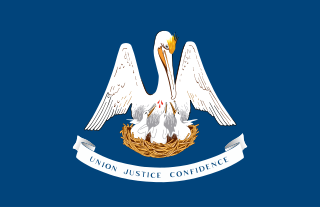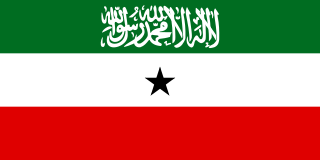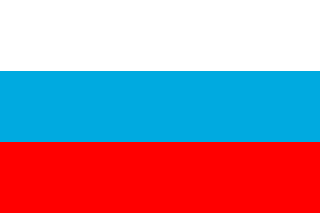
The national flag of the United States, often referred to as the American flag or the U.S. flag, consists of thirteen horizontal stripes, alternating red and white, with a blue rectangle in the canton bearing fifty small, white, five-pointed stars arranged in nine offset horizontal rows, where rows of six stars alternate with rows of five stars. The 50 stars on the flag represent the 50 U.S. states, and the 13 stripes represent the thirteen British colonies that won independence from Great Britain in the American Revolutionary War.

The national flag of France is a tricolour featuring three vertical bands coloured blue, white, and red. It is known to English speakers as the Tricolour, although the flag of Ireland and others are also known as such. The design was adopted after the French Revolution, where the revolutionaries were influenced by the horizontally striped red-white-blue flag of the Netherlands. While not the first tricolour, it became one of the most influential flags in history. The tricolour scheme was later adopted by many other nations in Europe and elsewhere, and, according to the Encyclopædia Britannica has historically stood "in symbolic opposition to the autocratic and clericalist royal standards of the past".

The national flag of Brazil, is a blue disc depicting a starry sky spanned by a curved band inscribed with the national motto "Ordem e Progresso", within a yellow rhombus, on a green field. It was officially adopted on 19 November 1889 — four days after the Proclamation of the Republic, to replace the flag of the Empire of Brazil. The concept was the work of Raimundo Teixeira Mendes, with the collaboration of Miguel Lemos, Manuel Pereira Reis and Décio Villares.

The Lone Star Flag is the official flag of the U.S. state of Texas. The flag, flown at homes and businesses statewide, is highly popular among Texans and is treated with a great degree of reverence and esteem within Texas. Along with the flag of Hawaii, it is one of two state flags to have previously served as a national flag of an independent country. In 2001, the North American Vexillological Association surveyed its members on the designs of the 72 U.S. state, territorial, and Canadian provincial flags and ranked the Texas flag second, behind New Mexico.

The national flag of Malaysia, also known as the Stripes of Glory, is composed of a field of 14 alternating red and white stripes along the fly and a blue canton bearing a crescent and a 14-point star known as the Bintang Persekutuan. The 14 stripes, of equal width, represent the equal status in the federation of the 13 member states and the federal territories, while the 14 points of the star represent the unity among these entities. The crescent represents Islam, the country's state religion; the blue canton symbolises the unity of the Malaysian people; the yellow of the star and crescent is the royal colour of the Malay rulers. It is in the stars and stripes family of flags.

The national flag of Ecuador, which consists of horizontal bands of yellow, blue and red, was first adopted by law in 1835 and later on 26 September 1860. The design of the current flag was finalized in 1900 with the addition of the coat of arms in the center of the flag. Before using the yellow, blue and red tricolor, Ecuador's former flag had three light blue stripes and two white stripes with three white stars for each province of the country. The design of the flag is very similar to those of Colombia and Venezuela, which are also former constituent territories of Gran Colombia. All three are based on a proposal by Venezuelan General Francisco de Miranda, which was adopted by Venezuela in 1811 and later Gran Colombia with some modifications. There is a variant of the flag that does not contain the coat of arms that is used by the merchant marine. This flag matches Colombia's in every aspect, but Colombia uses a different design when her merchant marine ships are at sail.

The national flag of Lithuania consists of a horizontal tricolour of yellow, green, and red. It was adopted on 25 April 1918 during Lithuania's first period of independence from 1918 to 1940, which ceased with the occupation first by the Soviet Union, and then by Nazi Germany (1941–1944). During the post-World War II Soviet occupation, from 1945 until 1988, the Soviet Lithuanian flag consisted first of a generic red Soviet flag with the name of the republic, in 1953 that was changed to the red flag with white and green bands at the bottom.

The flag of Louisiana consists of a rectangular field of blue with the arms of Louisiana, a pelican vulning herself, in white in the center, with a ribbon beneath, also in white, containing in blue the state motto: "Union Justice Confidence". The flag was officially adopted July 1, 1912, and is often referred to as the Pelican flag.

The flag of the state of Vermont displays the coat of arms and motto of the U.S. state of Vermont on a rectangular blue background. The Vermont General Assembly adopted this flag on June 1, 1923.

The flag of Somalia, also known as the Somali flag, was adopted on October 12, 1954, and was designed by Mohammed Awale Liban. The flag was initially used within the Trust Territory of Somaliland before being adopted by the short-lived State of Somaliland and the Somali Republic. It is an ethnic flag for the Somali people; the flag's five-pointed star represents the five regions in which Somalis reside.

The flag of the Turkish Republic of Northern Cyprus is the national flag of the Turkish Republic of Northern Cyprus and is based on the flag of Turkey, with the colors reversed and two additional horizontal red stripes at the top and bottom. The flag was drawn by the Turkish Cypriot artist Emin Çizenel. It was adopted in 1984 by Northern Cyprus, a self-declared state that is recognized only by Turkey, after its unilateral declaration of independence in 1983.
Transnistria is a region in Eastern Europe that is under the effective control of the Russian-backed Pridnestrovian Moldovan Republic but is recognized by the international community as an administrative unit of Moldova, the Administrative-Territorial Units of the Left Bank of the Dniester. The flag of the Pridnestrovian Moldovan Republic is a red-green-red triband, while the Administrative-Territorial Units of the Left Bank of the Dniester use the flag of Moldova.

The flag of Somaliland was adopted on 14 October 1996. It consists of a tricolour of green, white, and red, with a black star located in the centre. On the green stripe, there is the Shahada in white calligraphic script.

Galmudug, officially Galmudug State of Somalia, is a Federal Member State in central Somalia, with its capital at Dhusamareb. It is bordered to the north by the Puntland state of Somalia, to the west by the Somali Region in Ethiopia, to the east by Indian Ocean and to the south by the Hirshabelle state of Somalia.

The flag of Puntland is the state flag of Puntland, an autonomous state in northeastern Somalia.

Ahlu Sunna Waljama'a (ASWJ) is a Somalia-based paramilitary group consisting of moderate Sufis opposed to radical Salafism. The group opposes hardline capital punishment, stonings, and limb amputations advocated by extremist interpretations of Islam, as well as laws banning music and khat. The group seeks to protect religious shrines from demolition.

The flag of Columbus is the official municipal flag of Columbus, Ohio. Its current design is a yellow, white, red vertical triband with the city seal on a blue field. Officially, the flag was adopted in 1929, although it is unknown if the flag was ever flown when it was first adopted.

The flag of Azania is the state flag of Azania, an autonomous region in southwestern Somalia. The flag of Azania was similar to the one that previously existed in Russia from 1991 to 1993. It differed only in the aspect ratio, 2:3 instead of 1:2.
The flag of Earth is a concept of a possible flag design meant to symbolize the planet Earth, humankind, or a possible world government.





















